Winegard Connect marine WiFi and cell internet connection, simple and functional
I first mentioned my “installation” of a Winegard Connect because I was exercised about the cabling and mounting scheme Winegard employs. But the company deserves high marks for their response to my concerns, as they quickly had a proposed solution (explained below). While the Connect all-in-one WiFi and cellular get-online system — with the cell service included — is Winegard’s first entry into the marine internet market, they’ve been at it in the RV world for quite some time and the rock-solid RF performance is pretty impressive even if the interface seemed rather bare-bones to me.
The $479 Winegard ConnecT 4G1xM is a WiFi bridge, 4G/LTE modem, and router in a single enclosure. It provides the option to connect either via cellular bandwidth purchased directly from Winegard or via a land-based WiFi network. If you have an existing boat network the Connect can be connected via Ethernet to your network or you can use the WiFi in client devices like your laptop or tablet direct to the Connect.
 Winegard offers two basic types of plans, U.S. and Canada or U.S. only. The U.S. only plan is available with a 10gb bucket of data for $65. I quickly convert any plan to cost per gigabyte and at $6.50 per gig this is decent value. The 1, 3, 10, and 20gb plans for $20, $35, $80, and $150 add service in Canada and get as cheap as $7.50 per gigabyte. The multiple options and cost per gigabyte compare favorably to what KVH is offering with their LTE-1 and the single plan of $200 for 20 GB.
Winegard offers two basic types of plans, U.S. and Canada or U.S. only. The U.S. only plan is available with a 10gb bucket of data for $65. I quickly convert any plan to cost per gigabyte and at $6.50 per gig this is decent value. The 1, 3, 10, and 20gb plans for $20, $35, $80, and $150 add service in Canada and get as cheap as $7.50 per gigabyte. The multiple options and cost per gigabyte compare favorably to what KVH is offering with their LTE-1 and the single plan of $200 for 20 GB.
The Connect 4G1xM has two WiFi radios, one for connecting to shore-based WiFi and one for client devices on the boat to connect to the unit. Both of these radios are single band 2.4ghz radios. As has been talked about a lot recently, the 2.4ghz band presents some challenges in RF dense areas. So, while the 2.4ghz band comes with greater range than 5ghz, I’m still a little sad to see 5ghz omitted here.
When Ben Ellison and I sat down with Winegard’s leadership at the 2018 Miami Boat Show they stressed their roots. Winegard is based in Burlington, Iowa, and they produce almost everything in-house with an impressive array of capabilities from software engineering to an onsite print-shop.
I covered the process of connecting to a WiFi network on the Connect in my article comparing the interfaces of several WiFi systems, so I’ll focus a little more on the LTE aspects in this article.
Installation
The Connect can be mounted either on a standard 1″ 14 marine antenna mount, as can be seen in the photo on Have Another Day, or with an included deck mount adapter that threads into the 1″ 14 hole on the bottom of the unit. The cat5 cable that carries power to the unit and allows connecting to the boat network comes through the hole so you will need to find a mount with a cable slot cutout (like the Shakespeare 4188-SL I’m using) or with a hole large enough to pass the RJ-45 connector through.
A power over Ethernet (POE) injector is included to power the unit and I was happy to see that it’s a 12v model which makes installation easier for most boaters. A cat5 cable runs from the POE injector to the cable coming out of the bottom of the Connect. This one connection is all that is needed between the unit and the POE injector. If you’re going to use WiFi between your device and the Connect, you’re done with the installation. But If you’re using a wired connection to the boat’s network — known as a local area network or LAN — or straight to a computer below, you will plug its cable into the LAN port on the other side of the POE injector.
The user interface
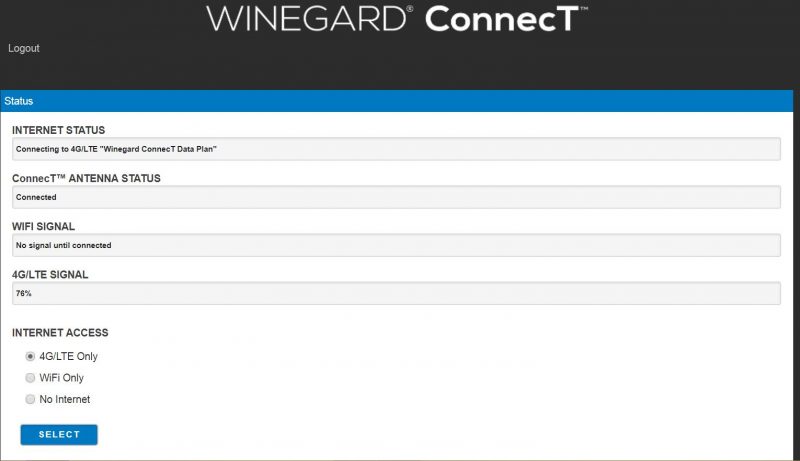
The Connect’s initial screen shows you current status including connection type and signal strength and lets you change between LTE and WiFi external connections
The Connect’s user interface stresses simplicity with minimal bells and whistles. For instance, the change from 4G to WiFi is done manually to avoid any usage or billing surprises. Although the simple user interface worked well for me, overall it feels a little clumsy. For instance, there’s no top or side navigation function in the interface; instead, all pages are selected by scrolling to the bottom of the screen and pulling down a menu to select your desired page.
Some diagnostic information is available as can be seen above. This includes a bit of information about the client devices connected to the Connect and the WAN (wide area network or internet) connection. There’s not in-depth diagnostic information exposed to the end user that a power user might like. I did also find myself wishing that when the unit was on 4G/LTE it displayed data usage more prominently.
Performance
I’ve had the Connect on Have Another Day since spring launch and our summer cruise up Lake Michigan and into the North Channel of Lake Huron in Canada included spots with minimal cell coverage. I also had several other marine internet devices and my trusty NetGear LB1120, but every time we found ourselves in borderline cellular service the Connect has been the last device to lose connectivity.
For example, we spent a night in Baie Fine, which is one of the few fjords in North America and a well known cellular dead spot. Indeed, as we pulled into the fjord we watched our phones and tablets go from full coverage to no-signal. After dropping the anchor I fired up a browser and consulted the user interface on the Connect. Though there wasn’t a ton, there was enough service to get iMessages out to family and a few emails in to maintain contact with the outside world. Notably, the Connect was the only device with any service that evening, a fact that proved especially helpful when retrieving weather information about a straight-line squall headed directly over us.
I have several other data SIMs on the boat, incidentally all ultimately on AT&T’s network. Two are part of my voice plan direct with AT&T and one came from a reseller who provides (sort of) unlimited bandwidth, and sometimes during our Canadian stay I had difficulty getting any of them to work. I’d find myself swapping the cards between the Shakespeare WebWatch, Wave WiFi MBR-550, NetGear LB1120, NetGear NightHawk MR1100 and iPads hoping for activation, and when they did, the performance varied widely and apparently regardless of service availability; sometimes I’d see 8-10 Mbps of throughput while other times I’d struggle to get 1 Mpbs. I don’t believe this was the fault of the modems or antennas, but rather the vagueries of international data roaming.
By contrast, the Winegard just worked. The only variations I saw in speed seemed to correlate to cellular service range, and as I mentioned above that was typically stronger on the Connect than other devices. As I mentioned in my WiFi device comparison article, the Connect also had very strong WiFi RF performance. It consistently pulled in the most networks and seemed to cope better with borderline signal strength.
Connector challenges
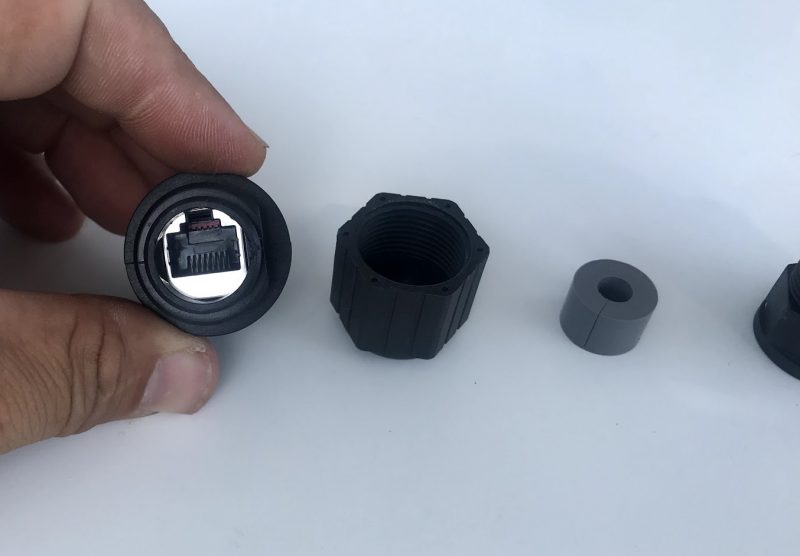
I was impressed with Winegard’s response to my concerns about the RJ-45 connectors exposed to the weather, which was the quick delivery of an Amphenol waterproof RJ45/Cat6 cable coupler (like this one at Amazon). That coupler, pictured above, does a very nice job of sealing off the cable ends from any weather. At the same time, Winegard let me know they are considering other options to better weather seal that vulnerable connector. The Connect is a marinized version of a product designed for the RV world and I think the issues I saw are the result of a use differing from the original design.
Final thoughts
Overall, the Connect is a slightly odd looking but very effective product. The user interface isn’t sexy and there aren’t a ton of bells of and whistles. However, the Connect just works. The unit was reliable, the RF performance was very strong and Winegard makes getting 4G/LTE internet service very easy. If you intend to use large quantities of bandwidth or need more advanced features there may be a better fit, but for a reliable simple system the Connect is easy to recommend.



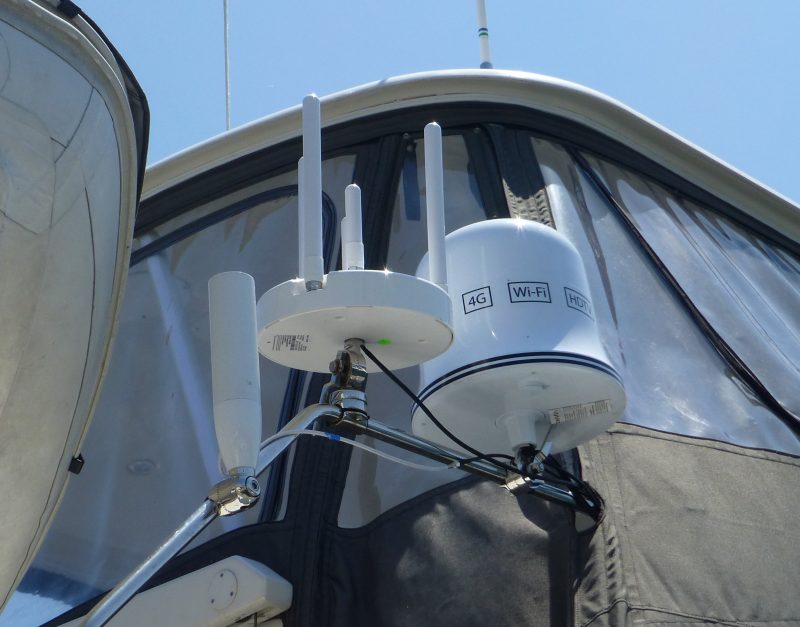
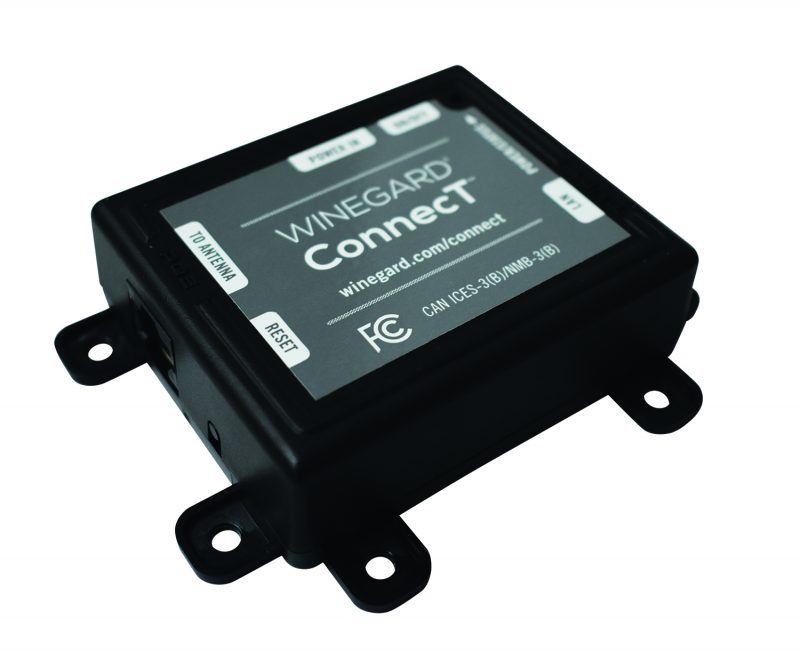
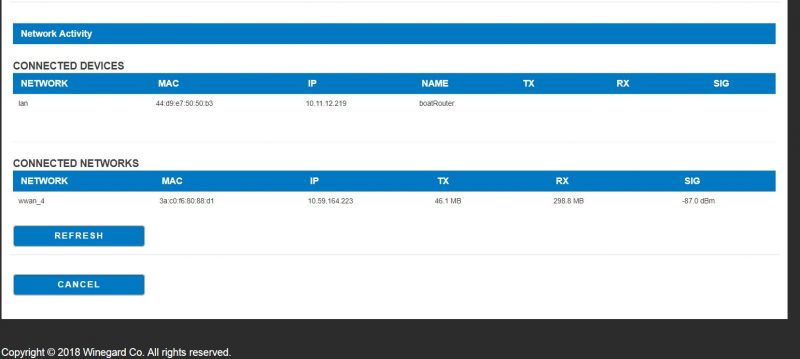
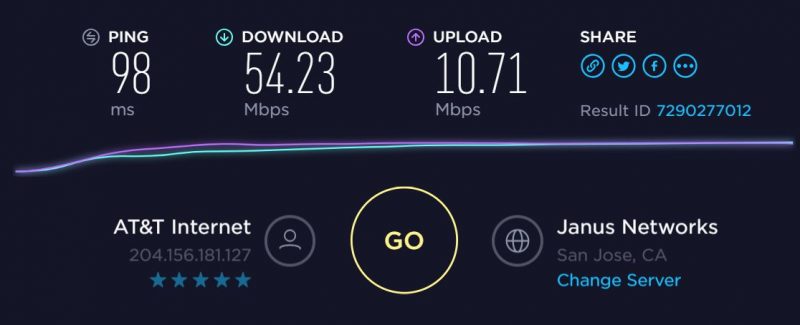











I should also mention one consideration I’ve found with the shape of the unit. As you may be able to see in the picture the Winegard is mounted on the aft end of the flybridge level of Have Another Day, right at the boat deck. That’s the bow of my dinghy just visible. when the dinghy is being moved by the crane I have a bow line on as a tag line. A couple of times now that line has ended up in the antennas of the Connect. It wouldn’t take a lot for a line to wrap around one of the five antennas. I’m guessing if it did and any force were applied the line would win over the casing of the Connect.
Thanks for the review, Ben. I like how the interface is simplified, and that everything is all in one. The performance seems great as well – that is definitely a selling point. Omitting 5Ghz is really disappointing. I can’t use 2.4Ghz, even a high power Peplink or other solution, in a multitude of places that I visit, including semi-remote marinas.
I also wish you could use your own SIM card and provider and avoid any contracts or fees from a 3rd party. Both Winegard and KVH have very low overall monthly amounts for the price. It looks like they might be reselling AT&T?
Yep, Winegard is definitely reselling AT&T. I agree the limits are low if you’re a heavy user. I’m not sure that’s their target market though, seems to me they’re targeting the casual “just make it work” user.
Good to know on AT&T. I think the thing I’ve noticed after installing over 100 WiFi setups on other boats is that the “just works” goes to “everyone streaming Netflix” in about a week 🙂
Hi! On your picture of the Antennas is one at the very left that is interessting to me. Can you tell which Antenna bracket it is?
Best regards, Baringa
Baringa, the mount is an Amazon special. It’s nice quality material and has worked fine for the antenna that’s on it. But, the hole in the center is pretty small so if you were running a cable down through it can be tough. https://amzn.to/2xCfH7s
2.4G only is a deal-breaker. Marinas are one of the most signal-dense WiFi environments you’ll find and having only three independent channels (one of which is taken by the AP) is a recipe for frustration. Between that, the antenna forest design, and the initial cabling issues, it sounds like this product needs at least another generation before it’ll be a good solution for the majority.
I want to be fair to Winegard, my mounting location is part of the reason the antenna forest design is an issue. If the device were on the hard top, up a mast, etc, that likely wouldn’t come in to play. I agree with you on 2.4ghz though on my own boat that’s a little less of a problem. I use a wired connection from the device to the boat network and have found the vast majority of marinas to only have 2.4ghz networks available (and generally poor service behind those 2.4ghz networks).
I was ready to plunk down some cash until the “you have to buy their data plan” statement. Do I really want another monthly cell bill? I have 4 users on my verizon data plan now, and another would cost $10/month and would give me another 15GB to use before data throttling on the (haha) “unlimited” plan. Looks like I’m still waiting for the right solution.
I don’t understand, Ron. Verizon shows their least expensive “Go Unlimited” plan as $40/month for 4 or more lines, and that data is all throttled, hotspot included, in comparison to the “Beyond Unlimited” plan I have, which would be $50/each per month with 4 or 5 lines: https://www.verizonwireless.com/plans/unlimited/
Plus I pay an additional $20 per month for “Smartphone line access” on each of the two phones on my account and that didn’t change when we went from 1 to 2. I’m not familiar with Verizon data-only plans, but don’t see anything like what you’re getting: https://www.verizonwireless.com/plans/connected-device-plans/
So I’d really like to know more about the Verizon plan you have. Links please.
My plan is the “unlimited” which is $190/mo and $20/mo for each smartphone. (sorry, I miswrote $10 in the previous comment) Throttling occurs after 22gb on the device or 15gb if used for a wifi hotspot. I am currently using the mifi 5500 device which allows an external Wilson marine antenna up on the mast, very necessary on a steel boat and it has worked up to 30 miles offshore. I have 4 devices on this plan, 3 smartphones and the mifi device. I can add one more device before I have to change plans to a business plan.
Thanks, Ron. Your plan sounds a lot like what I got from Verizon a couple of years ago when they only offered one “unlimited” plan and which is now called Beyond Unlimited. I had to fight hard to keep it when we added my wife’s phone but now have two lines with full speed LTE — what they call Premium LTE — to those 22gb/15gb(hotspot) limits for $110 plus the two $20 line access fees.
It’s really hard to track all the plans still active (though not necessarily available) but I’m pretty sure that if you added a fifth line you would also have to pay another $40 to 50 for your plan plus the $20 fee, for a total of at least $60 more on your monthly bill. And so far I can’t find where Verizon will let any of us add an unlocked SIM card as an additional line. If you or anyone knows how to do that, please tell.
What about coverage comparision with NeptuLink?
thanks,
I’m hoping to get my hands on a NeptuLink in the next few weeks and put it through its paces.
I know it might be a bit premature, but i hope you guys are keeping an eye out for cell receivers as they become available that are compatible with the upcoming 5G cellular. From what I know now, they should use existing LTE bands… but they are also working to add a new portion up in K-band. What this means is Winegard, KVH, and others will have to develop a new antenna system that adds the new band. All the major cell companies are talking and working to roll it out, but have not seen anything from the marine or RV suppliers…
I certainly will be watching for 5G options. I would expect a significant lag between the first products from the carriers and marine or RV specialists.
Sounds great, up until the requirement to use their data plan. We’re cruising in the SW Pacific. ATT, Verizon, Sprint…not applicable. If the Winegard Connect was unlocked so that we could use the best local cellular provider, which varies by locale and country, it would be a very attractive product.
Hi Ben,
Are you still using this system? Can you share any updates about it’s performance? Thanks!